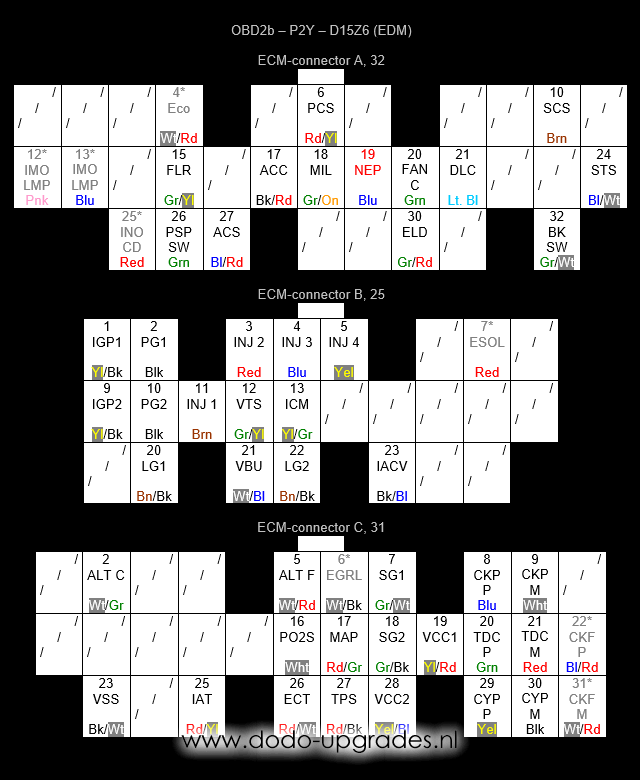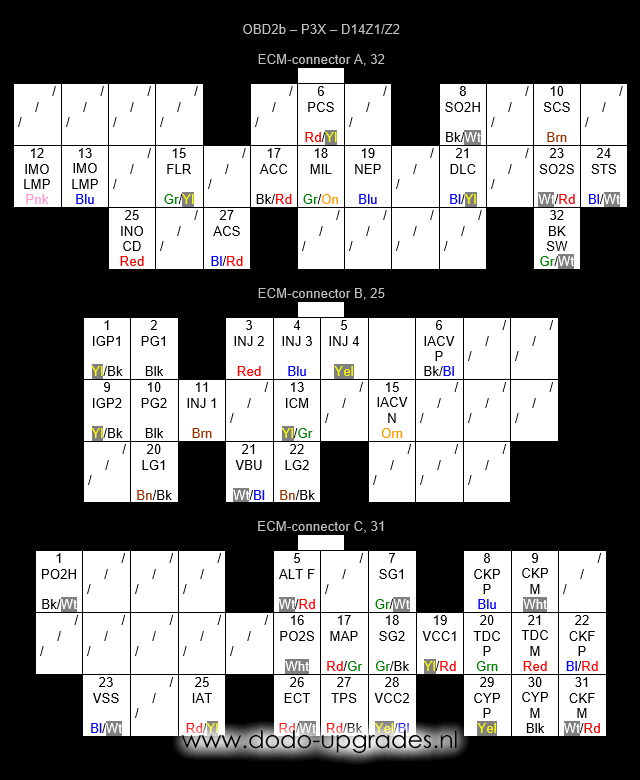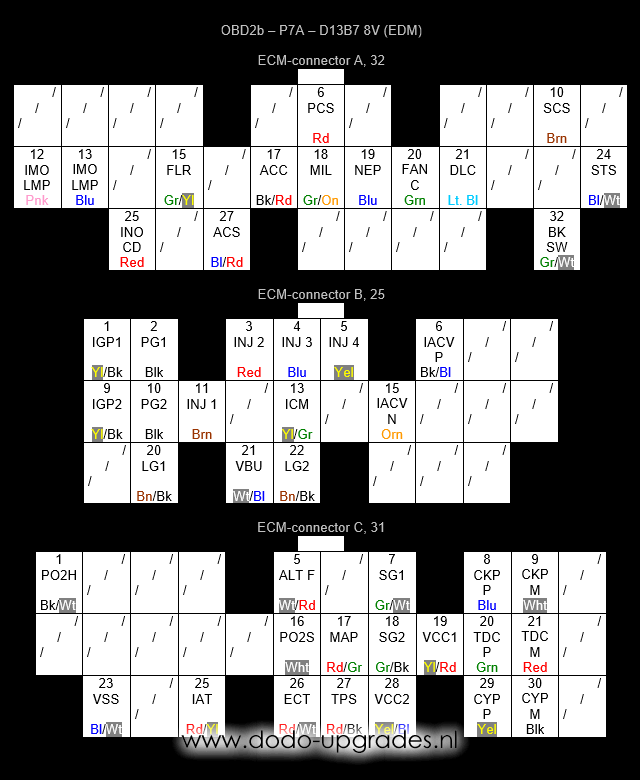EDM P2Y (D15Z6)
On this page some OBD2b shemes from mainly the EDM (Europen Domestic Market) are shown. Some connections are different from car to car. The first scheme is based on the D15Z6 found in most EK3 chassis. Below you will also find the P3X/P3Y found in EJ9 chassis after the facelift with D14Z1 and D14Z2 engines. Also the Honda Logo pinout for the OBD2b P7A ECU of D13B7 (8 valves). The first pinout serves as a general overview with most common connections in black fonts. Others are less important (read: often not occurring in OBD1 cars). Both types of connections are marked grey. The NEP connections marked in red deserves special attention.

Nomenclature:
ACC – A/C clutch relay
ACS – A/C switch
ALTC – Alternator relay, not always present
ALTF – Alternator switch
BKSW – Brake switch, not always present
CKF – Crankshaft speed, Pulse or Mass, gives 12 pulses by LED during each crank shaft rotation
CKP – Crankshaft position, Pulse or Mass, gives several pulses during each cam shaft rotation (20+ pulses)
CYP – Cylinder position, Pulse or Mass, gives 1 pulse during each cam shaft rotation
DLC – Data link connector
ECO – ECONOMO light
ECT – Engine coolant temperature
EGRL – Exhaust gas recirculation lift sensor
ELD – Electric load detection, not always present
ESOL – Exhaust gas recirculation control solenoid
FANC – Radiator fan relay, not always present
FLR – Fuel relay
IACV – Idle air control valve, controls 2 wire type valve
IAT – Intake air temperature
ICM – Ignition firing pulses
IGP – Battery feed, active when key is turned
IMO – Checks IMO code of the key and activates FLR if correct
INJ – Injector, the number refers to the cylinder used (1 is on the side with the belts)
INOCD – Checks IMO code of the key and activates FLR if correct
LG – Grounded shield for CYP, TDC, CKP, CKF and O2S wires
MAP – Manifold absolute pressure
MIL – Motor indication light, provides the blinking light (CEL) signal
NEP – Signal to engine speedometer driven by ECU
PCS – Purge cut-off solenoid
PG – Ground circuits, 1 and 2 are joined and connected to chassis at G101 at the thermostate housing
PO2S – Primary oxygen sensor signal
PSP – Power steering switch, not always present
SCS – Service check connector, short to SG2 to read CEL codes
SG – Sensor circuit ground, 1 is for the MAP circuit, 2 for all other sensors
STS – Starter switch
TDC – Top dead centre, Pulse or Mass, gives 4 pulses during each cam shaft rotation
TPS – Throttle position signal
VBU – Back up battery feed, always hot (unless battery is removed)
VCC – 5V sensor feed, 1 is for the MAP circuit, 2 is for all other sensors
VSS – Vehicle speed sensor
VTS – VTEC solenoid
OBD1 conversions are very straightforward even using only the schemes provided in the pinout section on my site. However the NEP signal needs some attention. In OBD2b this wire is a rpm signal send by the ECU directly towards the rpm gauge in the cockpit. However, all other OBD types provide the gauge with signal from the distributor instead of the ECU (IGR signal). For those other OBD types there are generally 9 wires on the distributor, OBD2b has only 8 wires. The blue one misses on OBD2b. The solution when installing an OBD1 ECU is simple, short the NEP wire to ICM somewhere and the rpm gauge should work.
Many OBD1 ECU’s use a VTM or VTPS (VTEC Pressure Switch) to monitor if there is enough oil pressure to engage VTEC safely. A few OBD1 engines and many OBD2 engines lack this VTM sensor. Not having the physical pressure sensor, but running an ECU that does need it will throw a code 22 engine error for VTEC oil pressue. This can be omitted by splitting the VTS wire and connecting the second end to VTM or VTPS on the ECU. This will let the ECU think there is enough oil pressure. Although preferably you should remove the VTEC oil pressure check from the ECU software if there is no physical sensor. The splitting trick generally works, but has caused me in the past to throw a code 22 once while driving.
Below is another pinout as exactly found on a OBD2b equipped EJ9 chassis. Very similar to ‘normal’ OBD2b:

Nomenclature additions and alterations specific for EJ9 Civis:
IACV N/P – Idle air control valve, controls 3 wire type valve, Negative and Positive
PO2H – Primary oxygen sensor heater control, connects to battery to activate the heater
SO2H – Secondary oxygen sensor heater control, connects to battery to activate the heater
SO2S – Secondary oxygen sensor signal
Below is another pinout as exactly found on a Honda Logo with D13B7 8V. Very similar to ‘normal’ OBD2b and almost exactly the same as the EJ9 version above:

Please, send any questions and/or remarks to me.
Dodo Bizar

9 replies on “OBD2b Pinouts”
Hi, first of all I’d like to say that you are a God of D series 😉
Question: is the pinout on D15Z8 the same? If not, what are the differences?
Thnx Evan, I may get back to this question later, but isn’t the D15Z8 always a OBD1 similar type ECU? ECU code P9L to be precise. I actually got hold of the pinouts of this engine just days ago while having owned a Civic with stock D15Z8 for years… Two tips, 1) if it is the P9L and you want to run it on P06/P28/P30 ECU: the A-plug doesn’t fit unless you remove two little pieces of plastic from the connector (you’ll see) and 2) remove D3 and D14 pins from the ecu (edit D5 and D6 in classic OBD1 notation, see below). Those are for the CKF sensor and will ruin the lambda control on ‘real’ OBD1 ECU’s if those wires/CKF sensor are kept.
Auch, when I said remove D3 and D14 in the other reply, that is according to the tranpsposed numbering Honda used for their ECU’s after ~1996. So in ‘classic’ OBD1 numbering it is D5 and D6 that need to be removed. (so third couple of pins from the left on the D-connector). I’ll get the pinouts sorted in the OBD1 section soon.
Cómo es el cableado para la iacv de dos cables hay que unir algo más o simplemente se conecta el cable de iacv a iacv?
Hi Kevin, the above OBD2b scheme is already from a 2-wire IACV car.
A 3-wire IACV would have had [B6 – IACV P] and [B15 IACV – N]. A 3-wire IACV car does not have [B23 – IACV]. In that case I would move the B6 to B23 and have B15 deleted. Often with wire harnesses both B6 and B23 are connected together.
hey so how should i connect to take file out the d15z6 p2y ecu
You mean reading the eprom? I have no idea, thats not my cup of tea.
Just would like to add to the NEP issue one side note. Any conversion harness from Aliexpress has already shorted wires from ignition pulses to the NEP pin so you don’t have to think about it. It really is just plug’n’play.
Harness like this: https://www.aliexpress.com/item/1005003497706014.html?spm=a2g0o.productlist.0.0.6ed86b45U9hwIM&algo_pvid=70c2209b-4d24-4cc0-b4d3-fa400c79dd3e&algo_exp_id=70c2209b-4d24-4cc0-b4d3-fa400c79dd3e-2&pdp_ext_f=%7B%22sku_id%22%3A%2212000026062648106%22%7D
Thanks for the info!